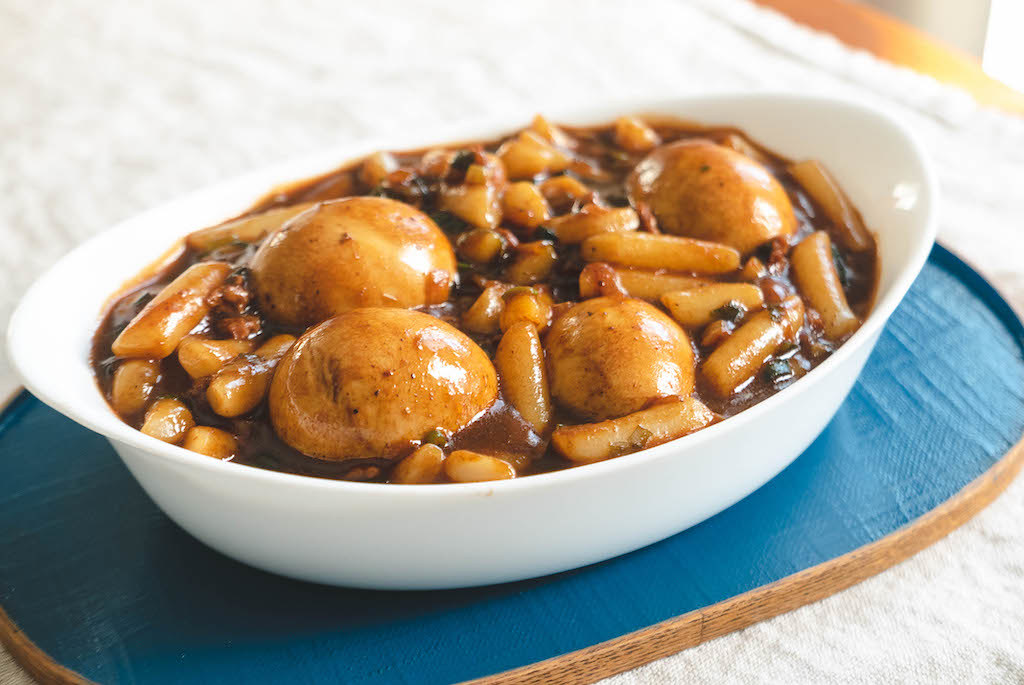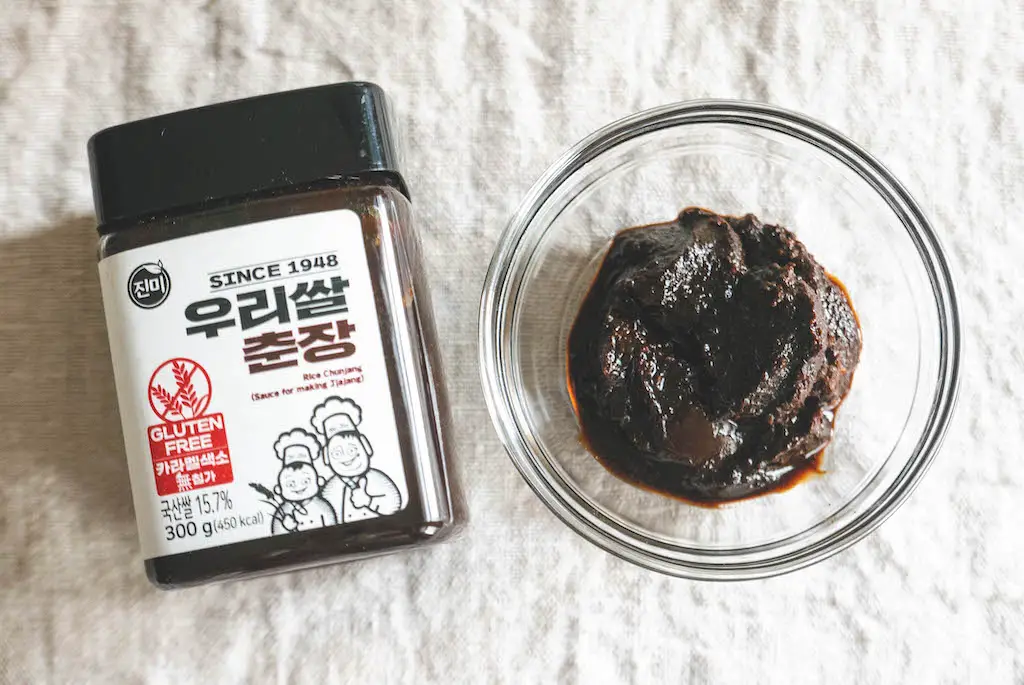This post may contain affiliate links. Please read my disclosure for details at the bottom of this page. As an Amazon Associate, I earn from qualifying purchases on this post about Korean black bean paste, otherwise known as chunjang.
Like in the United States, South Korea has a huge Chinese food takeout culture. Also like in the United States, Korean Chinese food has adapted and changed until it no longer tastes authentic to match the Korean preferences and palate. Undoubtedly, the most famous Korean-Chinese dish in and outside of South Korea is jjajangmyeon, a wheat noodle dish topped with a thick brownish-black sauce.
The sauce used for jjajangmyeon is known as jjajang (짜장)–otherwise known as ‘fried sauce.’ The main ingredient of the jjajang sauce is ‘chunjang’ (춘장). Here, we will discuss chunjang as an ingredient as well as Korean-Chinese dishes made using this sauce.

What Is Chunjang?
Korean black bean paste, known as chunjang (춘장), is a Korean cooking ingredient made by fermenting soybean in salt and wheat flour. Then, caramel coloring is added to the fermented soybean mixture during the aging process.
While chunjang was first introduced to the Korean peninsula through Chinese merchants, the taste and the fermenting process have evolved and changed to fit the Korean population’s flavor palate. The Chinese sauce which influenced Korean chunjang is known as ‘Tianmian sauce.’
What Does Korean Black Bean Paste Taste Like?
On its own and uncooked, chunjang tastes salty and slightly bitter. I would not recommend taste-testing this ingredient on its own.
When cooked with other ingredients such as oil, fresh vegetables, and sugar the flavors transform. Instead of overpowering saltiness and bitterness, chunjang adds rich savoriness to a dish.
Examples of Chunjang in Korean Cuisine:
In South Korea, people mostly use chunjang when preparing Korean-Chinese dishes. Below, we list three dishes that use chunjang to make a jjajang topping sauce.
- Jajangmyeon (자장면) or Jjajangmyeon (짜장면): This is a famous Korean-Chinese noodle dish made with wheat noodles and topped with a thick brownish-black sauce made using chunjang, vegetables, and pork. Other variations use different types of seafood and meats.
- Jajang Tteokbokki or Jjajang Tteokbokki (자장떡볶이): For this dish, you replace the wheat noodles with Korean rice cakes. Once again, the sauce is made using chunjang with other ingredients. Also, people add eggs and fish cakes to the tteokbokki as well.
- Jajangbap or Jjajangbap (짜장밥): Finally, you make this dish by pouring the jjajang sauce over rice.
Where Can I Buy Chunjang?
You can easily find chunjang in Asian grocery stores such as H-Mart. If you do not live near an Asian grocery store, I recommend looking online. You can buy chunjang on Amazon!

Gluten-Free Chunjang:
Like I stated in my jajang tteokbokki post, it is incredibly hard to find a gluten-free chunjang paste. One of the main and traditionally necessary ingredients is wheat. Finally, after years of searching, my husband and I found gluten-free ‘chunjang’ (춘장) to make jajang sauce. A company in South Korea finally released a gluten-free chunjang brand!!!
Also like I stated in my jajang tteokbokki post, at this time, we recommend buying from the website ‘Hanpoom,’ a Korean website that ships to the United States. Sadly, this website is only in the Korean language, but I will write instructions for buying items below.
Note: While we found the sauce on one or two English language sites, we could not find much information to confirm the websites were legitimate companies at this time. So, we recommend ordering from ‘Hanpoom.’
Below, I list how to order items from Hanpoom. I know it is a pain to order something in a different language, but this site has tons of Korean options you cannot find elsewhere. Hopefully, I will find gluten-free chunjang available on an English website soon! Also, this is not a sponsored or affiliate product, I just really like the site.
How to Order from Hanpoom:
- First, create an account. In the top right-hand corner, there is a button in Korean written as ‘로그인.’ Or, just click here for the login page. Next, click on the button that says ‘회훤가입.’ This takes you to a page to create an account.
- Then, create a username in the top box, write your email in the next box, a password in the third box, and finally confirm your password in the fourth box. Creating an account allows you to order.
- Then, in the search bar copy and paste ‘춘장.’ You will see the chunjang sauce with a huge gluten-free marker.
- Next, add quantity and click the bright red button with the words ‘장바구니.’ To deliver to the United States, you must order past a certain price point. At this time, I believe it is 70 dollars. You can shop around for other Korean ingredients. This company also makes gluten-free ssamjang, doenjang, and gochujang.
- Finally, on the right-hand side, change the shipping location to the United States. Hit the big red button and it will lead you to shipping with English instructions! To check out, once again, hit the big red button.

We Hope You Enjoyed Learning About the Chunjang!
In the end, we hope you enjoyed learning about chunjang, otherwise known as a Korean black bean paste. If so, let us know in the comment section below. We will continue to write about different ingredients used in Korean and Southern cooking! If you would like to read more about cooking, you can find recipes on our blog.
Korean Ingredient Articles:
- Persimmon Fruit: Persimmons in Korean Cuisine
- Asian Pear: A Guide to Asian Pears in Korean Culture
- Baechu (Napa Cabbage) in Korean Cuisine
- What are Perilla Leaves (Kkaennip)?
- Dangmyeon (Sweet Potato Glass Noodles)
- Gochugaru (Korean Pepper Powder)
- Korean Soy Sauce: What Should I Buy?
- Gluten-Free Gochujang Brands; And
- Gluten-free Doenjang Brands
If you have any questions or comments, you can also email us at [email protected].
And, finally, we would love to hear from you through our social media as well! You can follow us at @carvingajourney on Instagram, Twitter, Facebook, and Pinterest. Or, if you would like more articles like these, you can subscribe to our blog by joining our mailing list. We hope you enjoyed learning about chunjang, otherwise known as Korean black bean paste! Soon, we will be publishing more recipes using this Korean ingredient! Thank you so much for stopping by!
Carving A Journey is a participant in the Amazon Services LLC Associates Program, an affiliate advertising program designed to provide a means for sites to earn advertising fees by advertising and linking to Amazon.com. Although we may earn commissions for our endorsement, recommendation, testimonial, and/or link to any products or services from this website, these opinions are my own and I fully support these products.


2 comments
I just wanted to thank you for this information. I have been searching for a gluten free chunjang paste for years. I loved jajjangmyeon growing up and tried making it from scratch using fermented black beans but could never get the taste quite right. No one seems to know how to make it without the chunjang either. Your directions worked perfectly and I’m now just days away from having this again!
Hi Michelle!
Thank you so much for the comment! I am so excited that you get to make jajjangmyeon again! Let me know how it turns out! Feel free to email me photos as well. ❤️